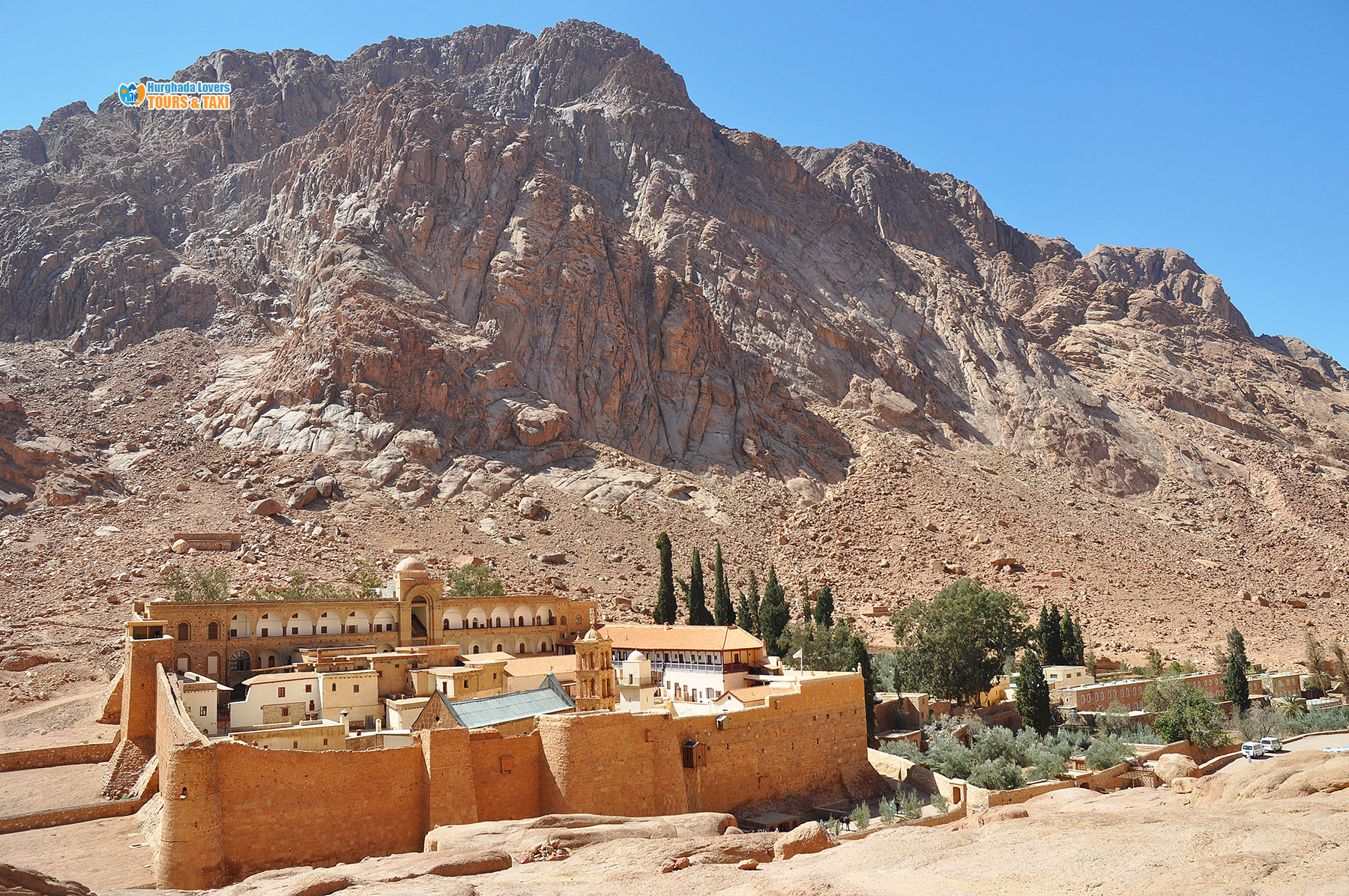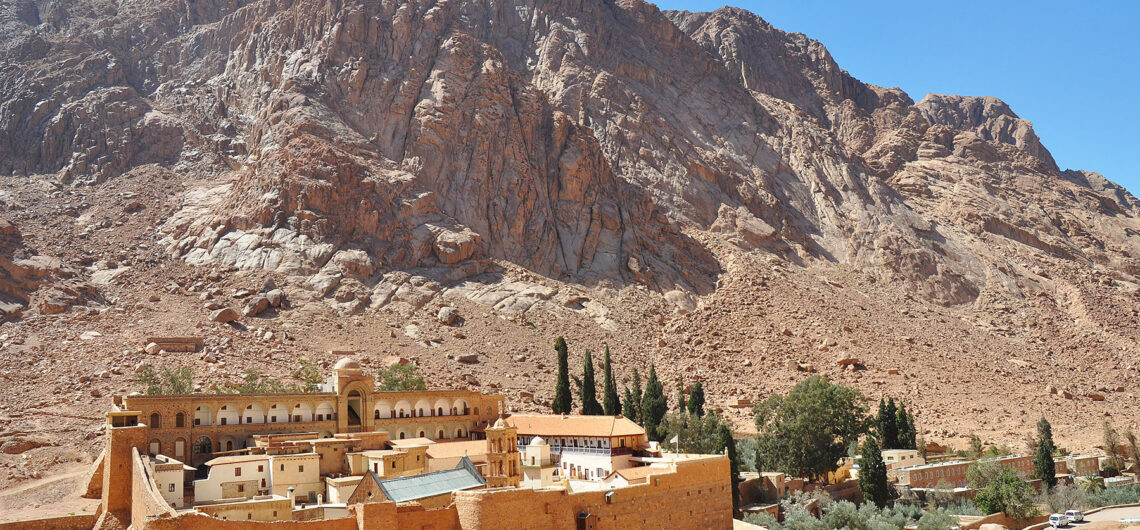Saint Catherine’s Monastery in Sinai, Egypt | The history of the sacred monastery of God on Mount Sinai, the facts of the most important Coptic monuments in Egypt, what is inside, what manuscripts were found in the monastery, and more
Saint Catherine’s Monastery, or as it is known as Saint Catherine’s Monastery, is an Orthodox monastery located in Sinai, specifically at the mouth of the strait at the foot of Mount Sinai and at the bottom of Mount Catherine, which is one of the highest mountains in Egypt. Learn about the story behind this monastery and some other information below.
Hurghada lovers Offer Luxury Hurghada to Pyramids Tours | El Gouna to Pyramids Tours | Makadi bay to Pyramids Tours | Sahl Hasheesh to Pyramids Tours | Soma bay to Pyramids Tours .
Historical overview of the Saint Catherine’s Monastery
• The monastery was built by order of Empress Helen, the mother of Emperor Constantine.
• The actual construction of the monastery was by Emperor Justinian in the year 545 AD.
• The reason behind the construction of the monastery is to suggest the relics of St. Catherine, who used to live in Alexandria.
• Although in the seventh century Sinai facilities for Christians were eliminated, the monastery still exists.
Saint Catherine’s story
• The saint was born in 194 AD and was called Zorosia, and she was known for her beauty and culture.
• Everyone desired her beauty, but she rejected everyone, and she converted to Christianity during the persecution of Christianity by Emperor Maximinus.
• The old accused the emperor of having made sacrifices to idols, so that the emperor tried to send her nearly 45 preachers to persuade her to turn away, but they converted to Christianity.
• Catherine was imprisoned and more than 200 people came to visit her, all of whom converted to Christianity.
• This made the emperor get angry and ordered the killing of Catherine on a thorny crushing wheel, but it broke when Catherine touched it.
• Then the emperor ordered the execution of Catherine, and it is said that the substance that came out of her neck was like milk, not blood.
• About three centuries after Katrina’s death, her remains appeared in a monastery-phobia dream.
• Those remains were transferred and placed in the church structure in a marble box, and the monastery became in its name from the eleventh century.
• There is a church in Alexandria bearing the name of St. Catherine.
The Burning Bush:
The most important Coptic Tourist Attractions in South Sinai of St. Catherine’s Monastery Egypt, the history, and secrets of the Holy Bush and what are the opening hours and prices of entrance tickets to start your religious journey in Egypt.
The most important religious tourist places of the Monastery of St. Catherine visit the Holy Mulberry in the south of Sinaï and learn about the history of the tree and the dates of visit and get to know the mirages of the servant.
The Attic tree of South Sinai, one of the wonders of the world’s plants, is a sacred tree according to the Christian teachings and is currently in St. Catherine’s Monastery.
It is said that this is the tree where the prophet Moses of his Lord survived, because this type of blackberry plant was nowhere else in Sina, a strange fruitless and green tree all year, and the attempt to regenerate it anywhere in the world failed.
About the Sacred Tree
This sacred tree is not blessed by Copts alone, but Muslims themselves see it as one of the signs where the prophet Moses arrived and indicated as his blessed path.
It first crossed the area of Oyoun Moussa (the springs of Moses), which is now 35 km southeast of Suez in Ras Sudr, which still generates fresh water to this day.
The second station is the area of the temple of Serabit El-Khadem 138 km southeast of Suez, the only area on their way to the Springs of Moses with statues, where the people of Israel asked the prophet of God, Moses to make it one of these statues.
The third station is the Sinai phase 280 km from Suez, a coastal city where the calf, made of gold, was made, and this area overlooked the sea, it is addressed to the people, that this calf will be burned, then exploded in the sea (Surat Taha verse 97).
The fourth station is the region of the Mount of St. Catherine, the only area of Sinai where several high mountains, such as Mount Moses 2242 m. from above sea level, Mount St. Catherine 2642 m. high and Mount Soliloquy, the area where the prophet Moses received the tablets of laws, is an area with high mountains, the same area where the prophet Moses saw a fire at the sacred tree (the Burning Bush) from his first journey alone.
Why the Burning Bush?
According to historical documents, Christian religious buildings in Sinai, such as monasteries and churches, were built in the stations of this road to be blessed in these places, especially the most famous of these places, the monastery of St. Catherine, where the sacred tree (mulberry tree) is located, a private plant that was not found anywhere in the city and failed to plant it anywhere. in the world, and Muslims built a mosque inside the monastery in fatimide times to bless this holy place, and religions met in one place.
This tree grows nowhere else, and all attempts to plant it have failed in any other soil.
The mulberry tree in the monastery of St. Catherine is the sacred tree where the prophet Moses saw a fire, when he saw a branch of the tree burn and the fire increases while the branch becomes greener, so that the fire does not burn the greenery, nor the moisture of the greenery and its water extinguishes the fire, He heard the voice of the almighty “God” and came to him.
This tree is religiously unique, with Empress Helena, mother of Emperor Constantin, coming in 336 AD to protest in the “Holy Valley” and seeing the sacred tree, and a small church in her arms that is still in her arms.
The beginning of pilgrimages for every Christian launched the world to visit the Burning Bush of Moses in Sinai and the journeys in the valley have continued so far with the same ancient rituals of climbing the mountain, crossing the gates of recognition and forgiveness, then climbing to the top of the mountain and landing to visit the monastery of St. Catherine through the entrance of the ancient pilgrims into the northeastern wall
Address
Visit the Burning Bushes, while you are at St. Catherine’s Monastery
Archaeological value of the monastery
• The monastery contains gifts from kings and princes made of silver. There is also a tree next to the monastery and it is called by some that it is the Moses tree.
• The monastery also contains Arabic mosaics, in addition to Russian and Greek icons.
• Inside the monastery there are oil frescoes and engravings.
• Inside the monastery there is a library of manuscripts in addition to the relics of St. Catherine.
• The entrance to the monastery is a small entrance with a height of 30 feet. This entrance was designed to protect the monastery from strangers or any intruder.
Manuscripts found in the monastery
• The monastery’s library, which is considered one of the oldest offices in the world, has a very large number of manuscripts that are not rivaled in this number in the world except the Vatican Library.
• In May 1844, Constantine Fo visited the monastery and discovered a Sinaitic manuscript that dates back to the fourth century.
• In 2003 the site’s manuscript was discovered.
• A collection of Palestinian Greek and Aramaic manuscripts was also discovered.
• In 1892 the Bible and a manuscript were discovered also in the name of the Syriac.
• The monastery also contains a copy of Ashtenami of Muhammad, where some claim that the Prophet Muhammad, may God bless him and grant him peace, was commissioned to protect the monastery.
• A copy was obtained from Mokivai as ‘arte lesi’, a collection of books by Kartlis Xufripa dating back to the ninth century.
• Among the icons that were found is the icon of the Virgin and Child with saints and angels, sixth century
• An icon of Christ the Pandemic of All, dating back to the sixth century AD, was also found.
• Holy doors of icons that come with two angels on the doors.
• Madonna and Child, a 13th century manuscript that was found.
• Manuscript of the Ladder of Divine Ascension, which embodies the idea of the straight path, but in a different way.
St Catherine’s Monastery Entry Times
Saturday through Thursday from 8:45 am to 11:30 am.
Friday from 10:45 am to 11:30 am.

